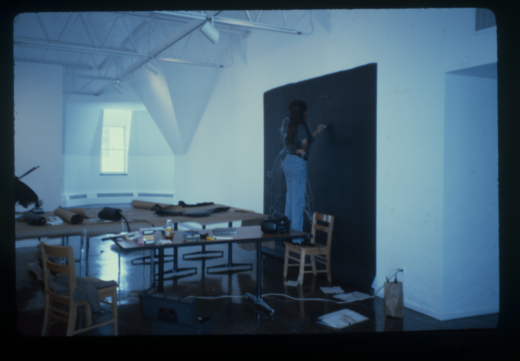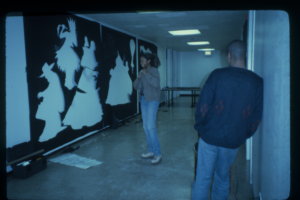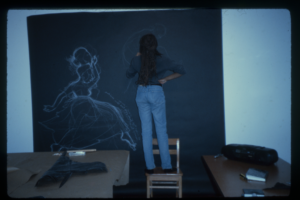From the Archive: Hamza Walker on Kara Walker

Kara Walker’s installation, Presenting Negro Scenes Drawn Upon My Passage through the South and Reconfigured for the Benefit of Enlightened Audiences Wherever Such May Be Found, By Myself, Missus K.E.B. Walker, Colored, now on display at the DuSable Museum of African American History as part of Toward Common Cause was initially conceived for the Renaissance Society in 1997. In that same year, just before she was awarded the MacArthur Fellowship, Kara Walker was quickly becoming known for her iconic black cut-outs that depict scenes of antebellum horror. During the 17th through the 19th century, prior to the advent of photography, the process of cutting black paper into the likeness of a sitter provided an affordable and popular medium of portraiture. Kara Walker turned to this obsolete medium in order to invoke a strain of historic memory that braids human chattel slavery with the American narrative across several hundred years.

As Hamza Walker, then Director of Education for the Renaissance Society, wrote of these scenes of vaudevillian abjection, “as angry, humorous, depraved, erotic, or disgusting as Walker’s scenarios may be, her embrace of derogatory stereotypes is confrontational for memory’s sake.” This panoramic and novelistic approach continues to allow Kara Walker to dredge the palimpsestic afterlife of slavery. And because the silhouette remains within a lineage of portraiture, Walker’s scene confronts us with questions about representation in the present.
Hamza Walker began writing the Renaissance Society broadside essays in the mid-nineties. Hamza Walker’s style coupled an epistolary address to Chicago’s South Side with a post-punk scholarly approach that made his voice indelible to contemporary art writing. Hamza Walker therefore became the perfect interlocutor for Kara Walker’s narrative. Here is Walker again:
“As black paper cut outs adhered directly to the white walls of the gallery, Walker’s work is put forth in no uncertain terms. Her world is quite frankly black and white. In fact, it is shameless. The work’s refusal to acknowledge shame when dealing with issues of race and desire set within the context of slavery, allows Walker to challenge, indeed taunt, our individual and collective historical imaginations.
[. . .]
Although her cut-outs have been likened to the literature of Toni Morrison, Alice Walker, and Toni Cade Bambara, Walker’s work actually shares more in common with dime store historical romances that use the ante-bellum as a backdrop. With human chattel as part of the historical mise-en-scene, it begs to be asked to what extent a romance could follow conventions of decency before the specter of perverse power relations would come into play. For Walker, this extent certainly is not great. Her vignettes are designed to upstage the entire genre. But Walker’s work exceeds parody. Using her artistic hindsight, slavery could just as easily have been dubbed “the perverse institution” by Sigmund Freud as it was “the peculiar institution,” by Frederick Law Olmsted. Her vision is a skewed triad of race, history and desire, that when it avails itself to a reading, avails itself to one of such surreal and psychological dimension that perhaps it is better to call it a diagnosis.
[. . .]
With historical accuracy effectively suspended, her cut-outs, for all their clarity, in the end become a Rorschach test whose highly subjective readings are consciously over determined. In avoiding Walker’s conclusions, however, it begs to be asked, where does our imagination go? Does it lapse into a moralizing tone? Or does it allow for more complex human relations to emerge, relationships which for better or worse either hurt, haunt or simply hover over us today, whether these specters be relationships between blacks and whites or simply our relationship to the stereotypes Walker employs?”

Read Hamza Walker’s complete essay on the Renaissance Society website
Kara Walker: Presenting Negro Scenes Drawn Upon My Passage through the South and Reconfigured for the Benefit of Enlightened Audiences Wherever Such May Be Found, By Myself, Missus K.E.B. Walker, Colored, is on display through October 16, 2021.
Kara Walker’s artwork is also on view at the Stony Island Arts Bank through December 19, 2021.